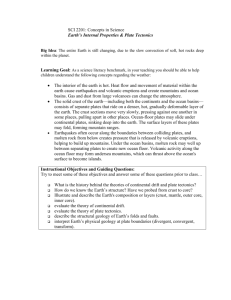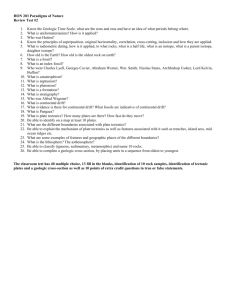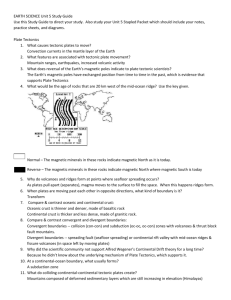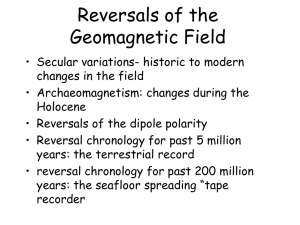ES11 U4 Plate tECTONICS AND CONTINENTAL
advertisement
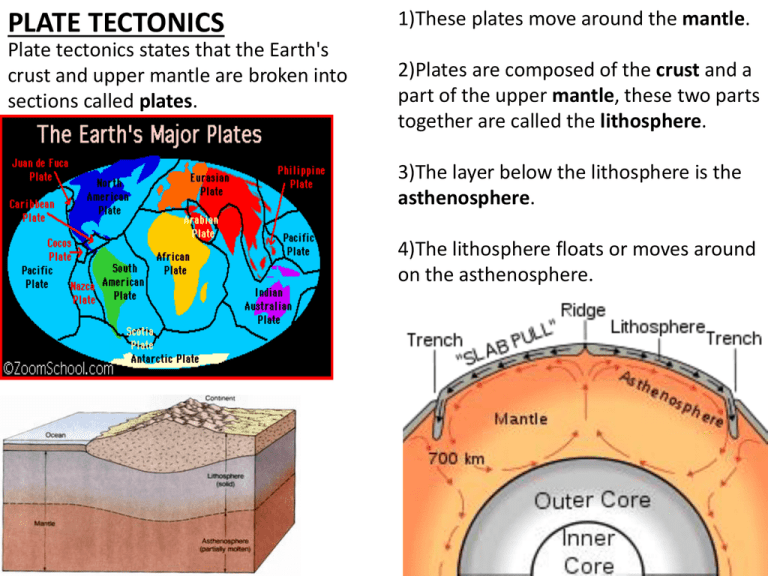
PLATE TECTONICS Plate tectonics states that the Earth's crust and upper mantle are broken into sections called plates. 1)These plates move around the mantle. 2)Plates are composed of the crust and a part of the upper mantle, these two parts together are called the lithosphere. 3)The layer below the lithosphere is the asthenosphere. 4)The lithosphere floats or moves around on the asthenosphere. The parts of the earth that are directly involved in plate tectonics are: a) The lithosphere (solid plates) b) The asthenosphere (plastic, moving ) The lithosphere floats on top of the asthenosphere and is pushed along like a boat on a river. MAJOR IDEAS IN PLATE TECTONICS Idea #1: Continental Drift 1) Alfred Wegener first proposes Continental Drift in his book published in 1915. 2) Suggests that 200 million years ago there existed one large supercontinent which he called Pangaea (All Land) 3) This was not really a new idea, but Wegener offered several lines of evidence in support of his proposal: Evidence A: Fit of the Continents -Wegener noted the similarity in the coastlines of North and South America and Europe and Africa. -Today the fit is done at the continental shelf and it is nearly a perfect match. Evidence B: Fossil Similarities – eg Mesosaurus, Lystrosaurus, Glossopteris -Reptile similar to modern alligator which lived in shallow waters of South America and Africa. Evidence C: Rock Similarities i)-Rocks of same age juxtaposed across ocean basins. ii): Termination of mountain chains. Continental Drift Idea was rejected by North American geologists because Wegener couldn't come up with a mechanism for continental drift. Suggested tidal forces, but physicists showed this to be impossible. Wegener dies in 1930 and his idea dies with him. Idea #2: Magnetism and Paleomagnetism 1) Earth behaves like a bar magnet with a magnetic north and south. a) At poles a compass needle dips vertically (Downward at the north pole, upward at the south pole and horizontal at the equator. ) b) Magnetic poles do not correspond with geographic poles. c) Magnetic pole moves as much as 25 km per year. 2) Cause of Earth's Magnetism •First thought to be the result of a permanently magnetized core. However, it has been shown that when any substance is heated above 500 degrees C it loses its permanent magnetism. •Earth is a Dynamo - Outer core is a fluid consisting largely of iron, so it is an excellent conductor. Electromagnetic currents are generated and amplified by motion within the liquid caused by convection. Rotation of the Earth unifies the random convective movements generating the magnetic field. Side Note: Variation is termed the magnetic declination. It is 16 degrees east in California. However, it has been found that even though the magnetic and geographic poles do not correspond today when the location of the magnetic north pole is averaged over a 5,000 year period it does correspond with geographic north. 3) In the 1950's scientists discover how to measure paleomagnetism (=magnetism frozen in the rock at the time it formed). a) With this knowledge scientists could tell the direction and latitude of geomagnetic pole at the time the rock formed. b) Found that by 500 MY ago magnetic north was located near Hawaii. Side Note: North American geologists attempted similar studies largely to disprove the Europeans. They found that 500 my ago North American rocks showed the magnetic north pole to be in the East Pacific, 3000 miles to the west of the European magnetic north at that time. Fred Vines supports Hess with his explanation of symmetrical magnetic stripes on either side of the Atlantic Mid-ocean ridge Geomagnetic reversal From Wikipedia, the free encyclopedia A geomagnetic reversal is a change in Earth's magnetic field such that the positions of magnetic north and magnetic south are interchanged. The Earth's field has alternated between periods of normal polarity, in which the direction of the field was the same as the present direction, and reverse polarity, in which the field was the opposite. These periods are called chrons. The time spans of chrons are randomly distributed with most being between 0.1 and 1 million years[citation needed] with an average of 450,000 years. Most reversals are estimated to take between 1,000 and 10,000 years. The latest one, the Brunhes–Matuyama reversal, occurred 780,000 years ago. A brief complete reversal, known as the Laschamp event, occurred only 41,000 years ago during the last glacial period. That reversal lasted only about 440 years with the actual change of polarity lasting around 250 years. During this change the strength of the magnetic field dropped to 5% of its present strength.[1] Brief disruptions that do not result in reversal are called geomagnetic excursions. SEA FLOOR SPREADING 1) Surveys of the ocean basins revealed a system of ridges and trenches with high heat flow over the ridges. 2) H. Hess (1962) rushes to print with the idea of Sea Floor Spreading. a) Postulates convection cells beneath ocean basins to drive the spreading. Types of Plate Boundaries 1) Divergent = plates spreading apart at the boundaries -Characterized by ocean ridges and sea floor spreading 2. Convergent = plates coming together -Characterized by trenches and island arcs -ocean plates are denser than continental plates SO… a)ocean plates go below continental plates when they meet (called subduction) b)When two continental or two ocean plates meet, they thrust up into mountain ranges Examples: Ocean - Ocean (Japanese Islands) Ocean - Continental (Cascade Mountains) Continent - Continent (Himalayas) 3. Transform= plates moving laterally along the boundary -Characterized by fault lines and earthquakes (eg San Andreas Fault) Convergent Convergent Divergent Divergent Boundary Convergent Boundary Additional Evidence in Support of Plate Tectonics a) Distribution of earthquakes along plate margins b) Location of earthquake foci along steeply-dipping subduction zones c) Age dating sediments on either side of the ridge indicates the sediments get progressively older away from the mid-ocean ridge axis d) Thickness of sediments also increases away from ridge Driving Force Behind Plate Tectonics 1.Convection Cells 2.Hot Spots- thermal plume rises from the mantle. -can occur in the middle of a plate (eg., Hawaii) Hot Spots





